Shochu from Izu Oshima’s Sweet Potatoes and Craft
Jan 17,2019
Shochu from Izu Oshima’s Sweet Potatoes and Craft
Jan 17,2019
Izu Ohshima is a volcanic island, which might be a surprise to many. Three underwater volcanoes between one million and several hundred thousand years ago, along with a newly emerged volcano, erupted repeatedly, giving birth to the island’s Mt. Mihara. Further eruptions and lava flows have shaped the island into its current form.
“We can’t grow rice here because we can’t form rice paddies. Instead, we grow sweet potatoes. Sweet potatoes grow well in the Izu Ohshima soil.”
Explaining this to us is Shinozaki Tetsuro, chairman of the Steering Committee for the Ohshima Local Produce Direct-Sales Center and local farmer affectionately known as Tecchan. Thinking about it, while circling Izu Ohshima, we had not spotted a single large river or pond, much less a rice paddy.
It simply comes down to the soil. Izu Ohshima’s soil has been formed mainly from lava and volcanic ash from volcanic eruptions. As such, it has excellent drainage, making it difficult for the soil to retain water or nutrients for any extended period. This makes it challenging to form reservoirs or rivers, so irrigating fields or creating rice paddies is out of the question. Sweet potatoes, on the other hand, thrive in warm, well-drained soil and are resistant to diseases. And since they are less susceptible to typhoon damage, they are perfectly suited to the climate of Izu Ohshima.
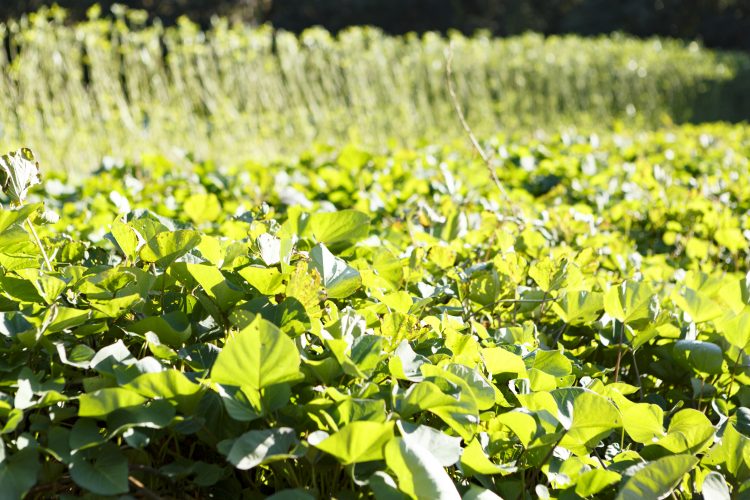
Since sweet potatoes grow underground, they are safe from typhoons. This is especially important on Izu Ohshima, where strong winds blow throughout the year.
Sweet potatoes were introduced to Izu Ohshima during the Edo period (1603 to 1868). Concerned about frequent famines, Tokugawa Yoshimune, the eighth shogun of the Tokugawa shogunate, distributed a translated version of Banshoko [Thoughts on the Sweet Potato] — the sweet potato bible compiled by Confucian scholar Aoki Konyo (who was nicknamed the Sweet Potato Master), together with sweet potato seeds to the Izu Islands. To the islanders, these sweet potatoes, which are resistant to adverse weather and disease, grow well in volcanic soil, are highly nutritious, and have excellent shelf life, were like a savior. They quickly became a staple food on Izu Ohshima.
Nearly simultaneously, Edo was engulfed in a sweet potato fad. The magnitude of the fad is captured by an old adage from the time, based on Japanese puns, that went “[Sweet potatoes are] better than chestnuts by thirteen ri [52 kilometers]”.
What fueled the fad was none other than baked sweet potatoes. Guards, known as bantaro, who kept watch over the gates to the samurai district, would diligently make baked sweet potatoes every morning from around 6 a.m. and continue until around 10 p.m. So prevalent was the fad, it was said, that no area in the whole expanse of Edo lacked a baked sweet potato stall. The modern equivalent would be pancake or waffle houses in Harajuku today. It’s easy to imagine street corners filled with the sweet aroma of roasting sweet potatoes and the sight of people lining up with excitement on their faces.
Many sweet potatoes are grown on Izu Ohshima, thanks to its soil. Buratto House, a center that sells local produce directly to consumers, has many varieties of sweet potatoes available in the fall, including the classic beni azuma, the white-skinned and fluffy kogane sengan, the recently popular beni haruka, silk sweet, and anno imo. It’s amazing to watch how quickly they sell out. We asked several shoppers how they cook and eat sweet potatoes.
“I often use sweet potatoes in tempura.”
“I often use them to make kakiage [tempura made with vegetables and seafood].”
“We steam them, wrap them in plastic wrap, and then freeze them. Later, we heat them up in the microwave and have them as snacks.”
Tecchan, the farmer who initially told us about sweet potatoes, picks up the story. “Baked sweet potatoes are delicious, right. Each year, I make baked sweet potatoes and sell them at Buratto House. When fall rolls around, people start asking me ‘When are the baked sweet potatoes coming?’ Beni azuma and silk sweet are popular because they’re sweet and moist.” We also learn that it’s currently harvest season for sweet potatoes.
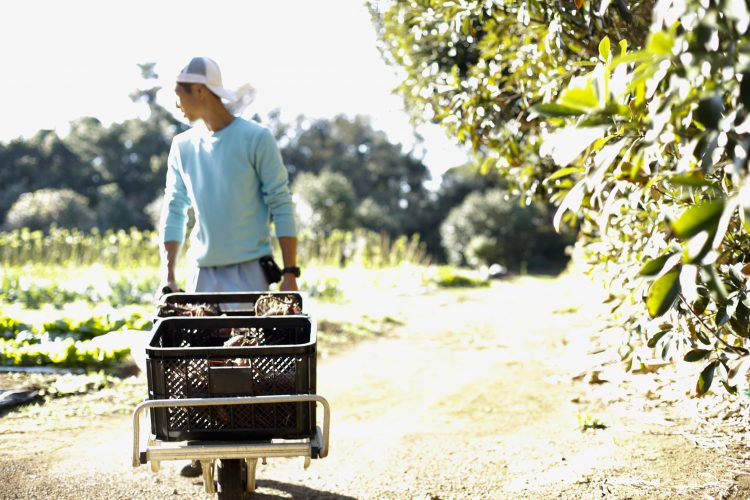
The sweet potato harvest begins around October at Tecchan’s farm. At the same time, requests for baked sweet potatoes surge. Sweet potatoes are a favorite on the island.
We decided right there to visit Tecchan’s farm and experience digging for sweet potatoes ourselves.
Following a single stem and carefully digging up the soil around it, we come to several sweet potatoes lined up like chums in the soil. Holding the stem at the base and giving it a final firm yank and up comes a cluster of deep reddish-purple sweet potatoes. For a moment, we feel like children again, excitedly digging up sweet potatoes. Looking up, we notice piles of cut stems and vines, known as imo gara, around the edge of the field. It seems a waste to throw them away.
“Back in the day, many homes kept cows and fed them potato vines and waste potatoes. But these days, almost no one keeps cows and to turn the imo gara into edible form is a hassle. Moreover, few people eat them nowadays.”
How about using them as fertilizer, we suggested on a whim. The answer was a flat no. Sweet potato vines don’t have enough nutrients to be useful as fertilizer.
“Fertilizer is vital for growing delicious sweet potatoes. We plant wheat after harvesting the sweet potatoes. When the wheat is ripe, we plough it under to use it as fertilizer.”
It feels extravagant, since wheat is a fine crop on its own, to use it as fertilizer. Sweet potatoes can grow in barren soil, but the recent improvements in taste are due to not just the introduction of new varieties but also efforts like this.
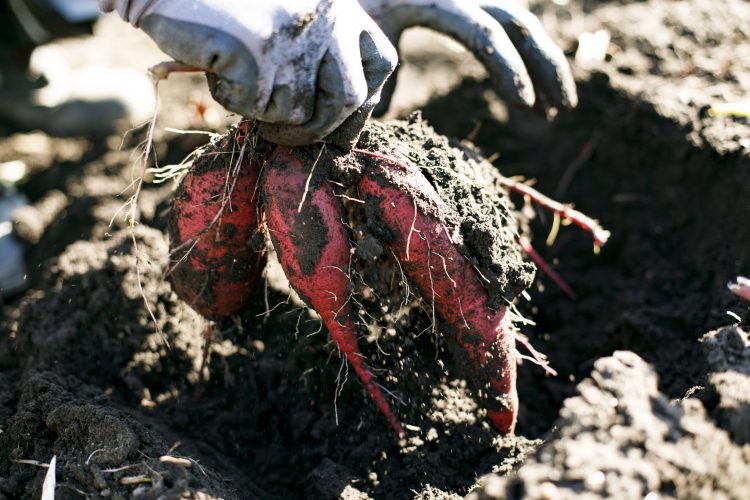
The soil is soft enough that you can dig and loosen it up with your hands
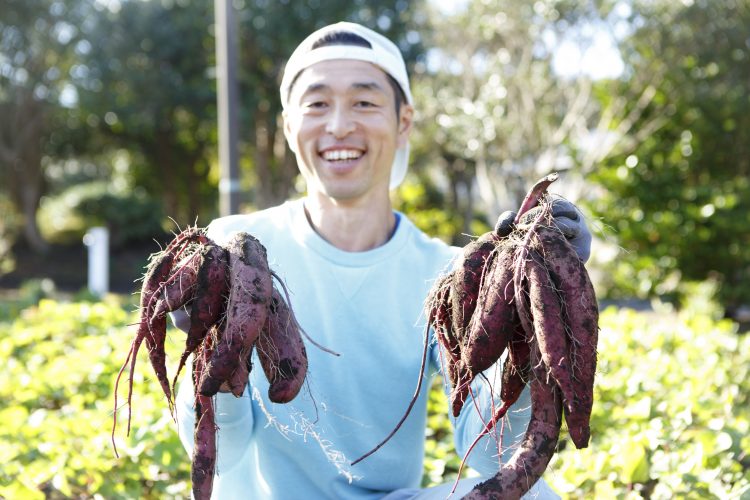
Shinozaki Tetsuro is known affectionately as Tecchan by everyone. Digging up such beautiful clusters of sweet potatoes is more nerve-wracking than you might imagine.
After our potato-digging experience, we entered the workshop where the air was filled with a subtle, fragrant aroma. A steaming pot sits quietly on a wood-fired stove. Lifting the lid reveals golden-brown baked sweet potatoes with starch oozing out from their cut surfaces.
According to Tecchan, you can tell whether the baked sweet potatoes have turned out well just by the aroma when opening the door to the workshop. With this aroma, surely today’s have turned out delicious.
We have a bite of a hot baked sweet potato. We were overcome by the swirling aroma of the baked starch.
“Recently the beni haruka, a moist variety, has become really popular. It has lots of starch, but it doesn’t overpower you,” explains Tecchan. And just as he said, the light sweet taste makes you want to keep on eating until you push the limits of your stomach.
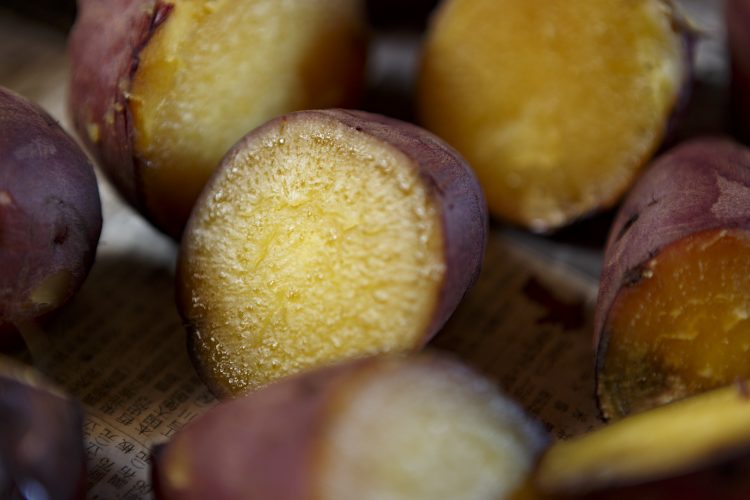
Stone-baked sweet potatoes made in a wood-fired stove. The stones are laid beneath the sweet potatoes. When the starch rises up to the cut surface, they are cooked. After setting them aside for a bit, the sweet potato becomes moist.
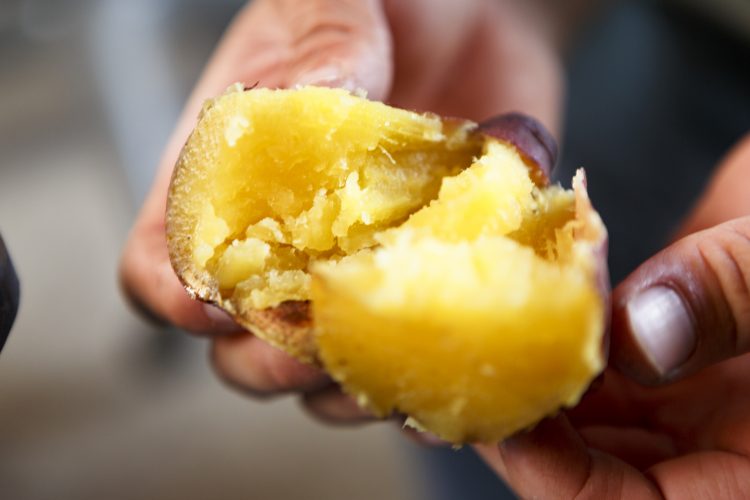
The skin is thin and can be eaten as is. The aroma of the cooked starch is irresistible. Freezing them makes for a yummy snack.
“While cultivating my crops, not just sweet potatoes, I’m always imagining how to prepare them in a delicious way. I got the idea that baked beni haruka would taste good as a potato salad, so we tried making it at home.”
The bags of sweet potatoes come with little notes about the taste characteristics of each variety and suggestions on how to eat them. Tecchan also takes the time to pass on recipe suggestions to the women who handle sales at Buratto House. Tecchan laughs. “I do it because I just love eating!” But even from his casual remarks, you can sense his sense of responsibility as a producer. You can almost see the pride of supporting Izu Ohshima’s food culture ripple down his spine.
On our way back, we found an inscribed stone monument next to a field. In addition to describing the strenuous labor of cultivating the land, it had the following passage.
“Those who shared in these hardships have seen the passing of a number of people. Do not forget your original resolve. In this village where little birds sing, flowers dance, and honey and milk flow, we compose this verse to commemorate the past and leave it for future generations. As islanders, we begin the spring with a single hoe.” [Excerpt]
These are the words left to us by Shinozaki Sogetsu, a haiku poet who dedicated his life to the development of Izu Ohshima. He was also Tecchan’s grandfather.
Farmers cultivating the fields. Islanders enjoying the sweet potatoes grown on this land to their heart’s content. Children who have been in touch with the soil since their earliest days, digging up sweet potatoes and experiencing the joy of harvest. Scenes of the dependable food left by their ancestors seem to have been passed along, embodied in the people living on this island where sweet potatoes are so beloved.
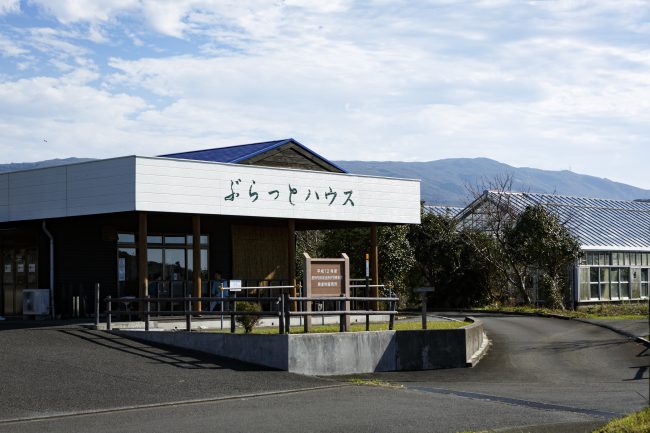
When people who enjoy alcohol think of sweet potatoes, the first thing they imagine is probably shochu distilled spirits. And shochu is primarily associated with the Kyushu region. But going against this generalization is the thriving production of shochu on the Izu Islands.
Shochu production on the Izu Islands is said to have begun in the late Edo period on Hachijojima. The production of grain alcohol was banned on Hachijojima at the time to prevent famine. Around this time, a merchant originally from Kagoshima named Tanso Shouemon, who had been exiled for smuggling, arrived on the island. Realizing that grains were off-limits but seeing that the island had plenty of sweet potatoes, he introduced the technique of distilling imo-jochu (sweet potato shochu), which was common in Kagoshima. The technique spread among the Izu Islands, and shochu production began on Izu Ohshima as well.
Taniguchi Shuzo is the only brewery on Izu Ohshima. A short climb up a steep slope leading to Mt. Mihara reveals a building straight out of a fairy tale. A single tsubaki camellia plant peeks out from the roof. Fittingly, the building is called Tsubaki Castle.
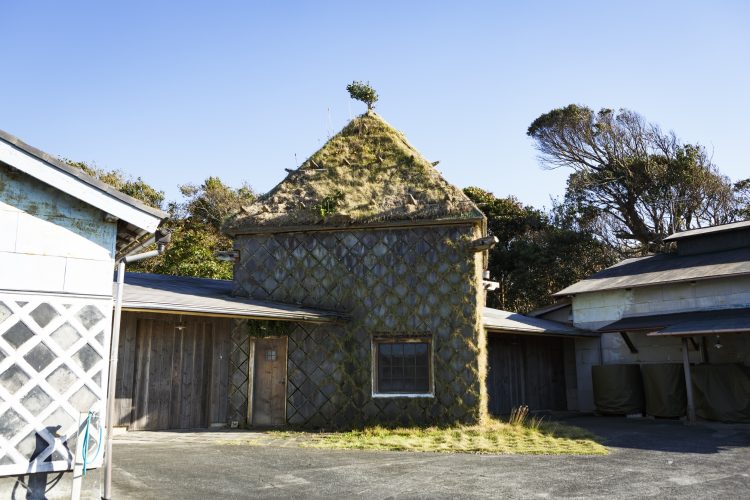
Tsubaki Castle was designed by the architectural historian Fujimori Terunobu. Upon entering, you can feel the building breathing as if it were alive.
“The entire roof is covered with soil and grass grows on it. It looks a little sad this time of year because it has dried out.”
Our guide is Taniguchi Eikyu, the third-generation owner and master brewer of Taniguchi Shuzo. He is a courageous man, producing shochu by himself at Izu Ohshima’s only brewery.
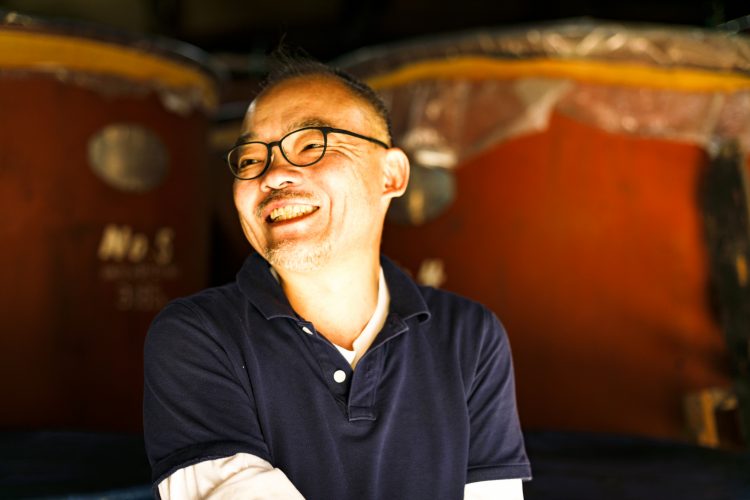
Taniguchi Eikyu, the third-generation owner of Taniguchi Shuzo. The very first shochu he ever made rests carefully in his cellar. He lets it mature while occasionally adding newly distilled shochu a little at a time.
“In the past, I’ve had master brewers and assistants come in, but now I do everything myself. No matter how much you trust someone, whether they are family or a friend, you are still mindful of them, right? I preferred to focus all that mindfulness into producing shochu.”
The primarily ingredient is pesticide-free beni haruka sweet potatoes. This variety is perfect for making shochu. If the sweet potatoes have too much starch, they become sticky and difficult to cool down, which disrupts the production process. When making imo-jochu, Taniguchi steams 200 kilograms of sweet potatoes at a time. Five batches total one ton of potatoes. He washes each potato separately, cuts off the ends, splits them in half to check the insides, and removes any damaged areas. Only after this operation does he start steaming and then mashing the potatoes.
“I make the barley koji in parallel with preparing the sweet potatoes. Just as you would rinse rice, I wash the barley, let it soak in water, and cook it for over an hour. Then I add the koji spores. While leaving it overnight, the koji mold proliferates throughout the steamed barley. I spread the barley out on special koji racks and let them propagate for another day.”
Moist air at around 40°C is blown through the koji racks, and Taniguchi tends the process to ensure the koji mold grows evenly. It takes about 40 hours for the koji mold to penetrate the core of the barley and cover its surface completely in white.
“It’s like raising a baby. You learn to pick up on signs when it’s hungry or lacking energy. Koji mold is very delicate and fragile. Temperature, humidity, oxygen levels, and time must be carefully managed, and it must be protected from other strong bacteria. While preparing the koji mold, I avoid eating natto fermented soybeans because it contains strong bacteria, and I don’t touch with my bare hands fruits or vegetables that have yeast.”
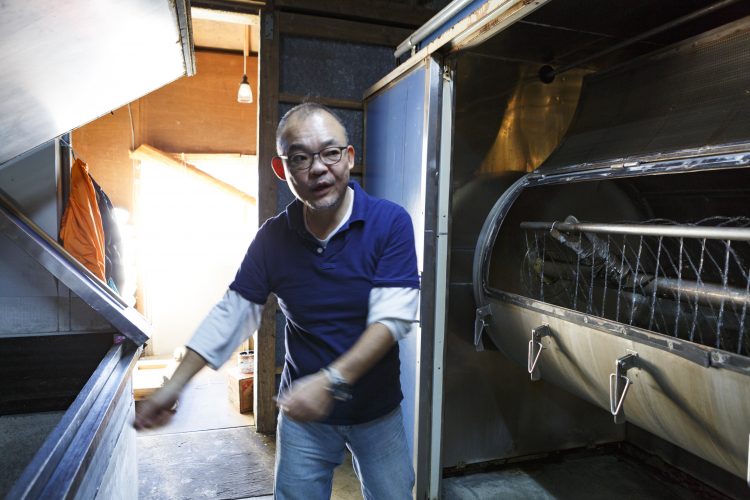
The machine on the right washes and cooks the barley. The koji racks on the left are where the koji mold is fostered. Taniguchi cooks 300 kg of barley in one batch. It’s quite physically demanding work when done in tandem with the sweet potato preparation.
The barley koji, grown from the koji mold, is transferred to tanks, where water and yeast are added. The fermentation finally begins in what is called the “first fermentation” stage. Water is essential to shochu production, but Izu Ohshima has no large rivers or rice paddies. So we were curious about the water Taniguchi uses to make his shochu.
“The water on Izu Ohshima is groundwater. Because the ocean is right at hand, even our tap water contains a trace of salt, making it unsuitable for producing shochu. Luckily, we have good spring water up in the mountain.”
Mt. Mihara, formed by layers of lava, acts as a natural filtration system. Rainwater slowly seeps through gaps in the lava over time before emerging as clean spring water.
According to the local history museum, before the modern water system was built in the 1950s, spring water was the only source of water. Women had to go to a spring every day to fetch water. Water is a precious resource on Izu Ohshima and has been cherished since ancient times. Even today, the places where spring water surfaces are revered as water deities. The wooden buckets carried on the heads of women in traditional attire, known as anko-san, were essential for daily water collection.
“Shochu brewers generally add salt during the first fermentation, but I use bittern instead. I spoke with Sakamoto Akihiro of Ohshima Ocean Salt, which produces salt here on Izu Ohshima, and he suggested that bittern would be better than salt. And sure enough, when I tried it, the mold bacteria became more active.”
Bittern is a solution produced as a by-product of making salt from seawater. It is rich in magnesium and other minerals. So it might be the effect of the sea’s minerals that give the mold bacteria a boost. Or perhaps it’s because they share the same roots on this land. It certainly reminds us that bacteria are living organisms.
▶See the article on Ohshima Ocean Salt here:
Oshima Ocean Salt: Natural Salt Crafted by Sea and Wind

The fermentation tanks are wrapped with cotton around the middle for insulation, creating a meticulously controlled environment
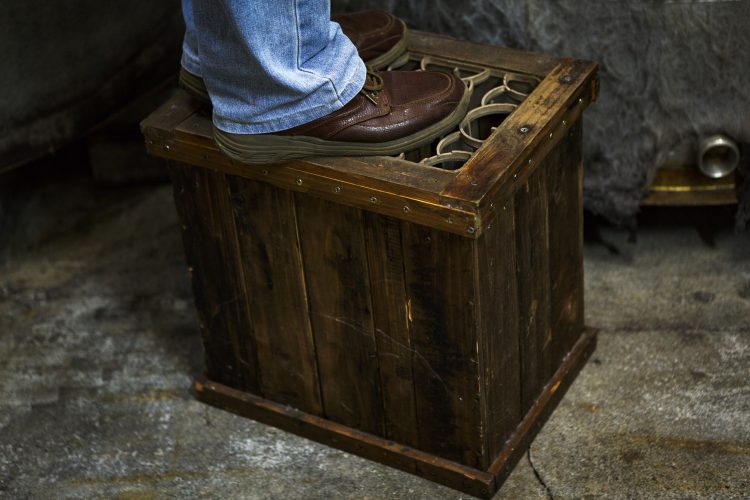
The step stool Taniguchi uses while working at the tanks was made by attaching wooden planks to a plastic saké case. He is attentive not only to functionality but also to appearances when arranging his workspace.
Now it is time for the sweet potatoes to finally take center stage. The mold bacteria that have grown vigorously in the first fermentation are called the “first mash”. These bacteria consume and break down large amounts of sweet potatoes, which serve as their source of nutrients, to produce alcohol. This, then, becomes the shochu base spirit. This process is called the “second fermentation”.
“I decided to play music to encourage fermentation during the second fermentation. I hung speakers up in the cellar and played Mozart’s ‘Requiem’ at a fairly high volume. And funny enough, the fermentation improved significantly. Playing Aerosmith’s ‘Get a Grip’ resulted in a messy taste, and Enya didn’t work either. It seems like ‘Requiem’ is the only thing that works.”
“Requiem” is a funeral mass. It’s a very dark and long piece of music. Taniguchi, who buries himself for about five months in the cellar every day from morning to night working on the brewing process, complains. “It’s tough to listen to because it’s so depressing.” Nevertheless, his eyes sparkle. In recent years, the term “music maturation” has emerged, and research on the relationship between music, fermentation, and maturation is ongoing. The idea that listening to music can make bacteria feel better is charming. We’re growing ever more attached to these microorganisms.
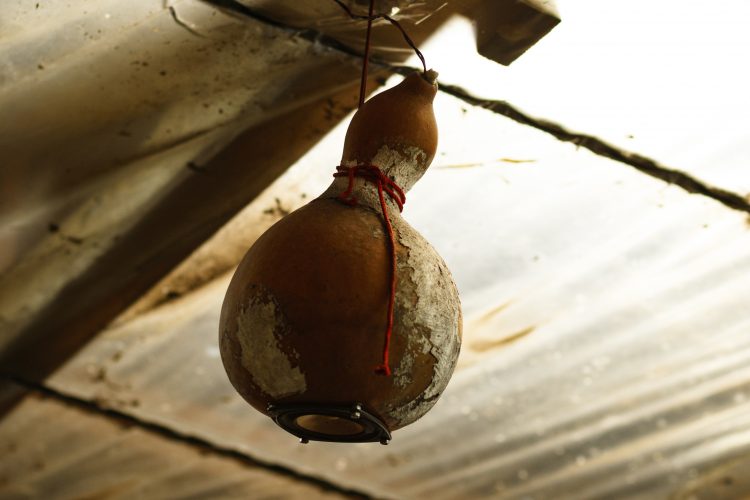
Taniguchi’s handmade gourd speaker. He plays “Requiem” through this at loud volumes.
The bacteria, which have fed on plenty of sweet potatoes, break down the starch in the potatoes. The fermentation continues until sufficient alcohol is produced. The alcohol is then distilled to create the base spirit, which is stored and aged.
“The base spirit contains a lot of oil, so as it ages, it oxidizes and develops an unpleasant odor. But if you remove the oil too early, you’ll lose the umami as well. I want to leave the umami and flavor impurities in just the right balance. Shochu changes in flavor over time. If you remove the oil during distillation, no matter how long you age it, the shochu won’t develop a delicious taste.”
Once you taste Taniguchi’s shochu, you’ll understand immediately. The umami and aroma that make you want to savor each sip are due to the perfect amount of oil content remaining in the liquid.
“My recommendation is to dilute the shochu with hot water and use two glasses. Keep pouring the shochu back and forth between the two glasses until it reaches your preferred temperature. Here, please try these.”
As you bring the offered glass to your lips, the gentle aroma reaches your nose, and when you take a sip, it spreads further, filling your mouth with a rich umami and sweetness. The taste profile has a splendid and exquisite depth. You can’t repress your joy at discovering this way of drinking shochu, and you begin to regret the decades you spent only drinking shochu on the rocks.

The trace oils that are dissolved by the hot water spread as you transfer the shochu between the glasses, releasing an astonishing aroma
“The power of the malt bacteria does much more of the shochu-making work than me,” says Taniguchi. “There would be no fermentation without the bacteria. I create an environment where the bacteria can thrive and I feed them delicious food. That’s what my job is.”
This year, Taniguchi is also trying his hand at growing sweet potatoes in a field on the mountain.
“I tried mixing the shochu lees that are left over from the production process in with the soil. This resulted in potato plants with larger leaves. I hope the potatoes will grow larger too. My plan this year is to make shochu with the sweet potatoes I grow on my own. The truth is making imo-jochu is a real hassle and I often think about quitting. But of course, I’ll never quit,” he says with a laugh. He continues with a serious expression. “It actually hurts when I sell shochu that has turned out delicious. But the shochu that’s the hardest to part with is the shochu that sells the best.” It seems that Taniguchi’s humanity has seeped into his shochu production.

Taniguchi’s first attempt at growing sweet potatoes. When he dug up some in a trial, he found he had grown excellent sweet potatoes.
Sweet potatoes grown right behind the brewery, spring water from the mountain, bittern produced from Izu Ohshima’s seawater, and koji mold that exists everywhere, though invisible to the eye — all these elements seem to work together under Taniguchi’s orchestration to create wonderful shochu. And all this happens under the watchful eye of Mt. Mihara, known as the Divine Fire.
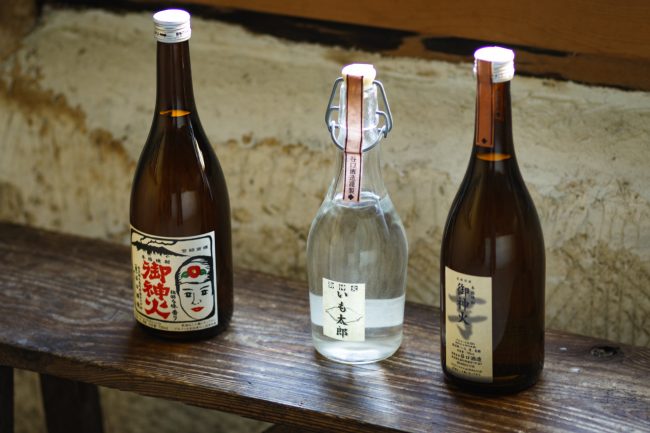
*Tastings (for a fee) and direct sales are available at Tsubaki Castle (reservations by phone are required). Online sales are available from the website.
●Getting to Izu Ohshima
Getting to Izu Ohshima takes an hour and 45 minutes by high-speed jet ferry or six hours by overnight ferry from Tokyo’s Takeshiba Sanbashi Pier. There are also ferry services from Kurihama Port in Kanagawa and Atami Port and Ito Port in Shizuoka.
Contact Tokai Kisen at 03-5472-9999 or 0570-005710
URL:https://www.tokaikisen.co.jp/